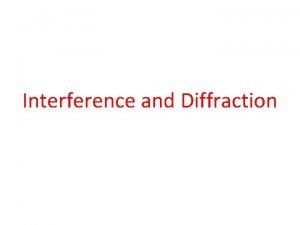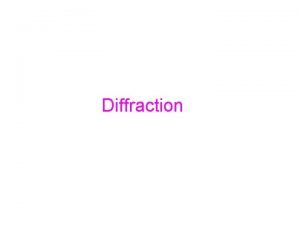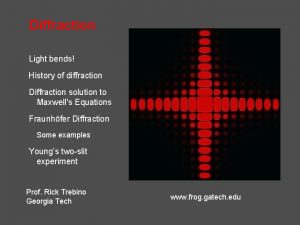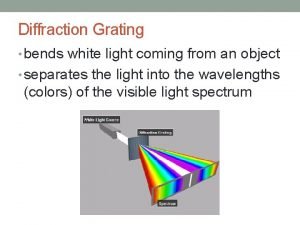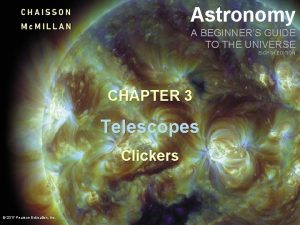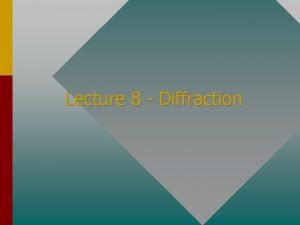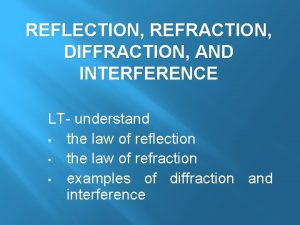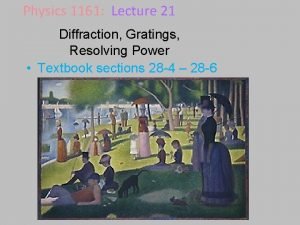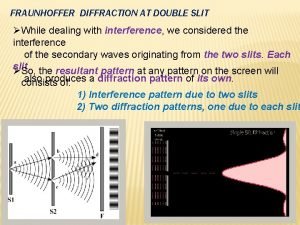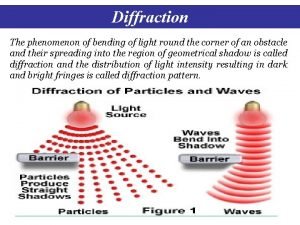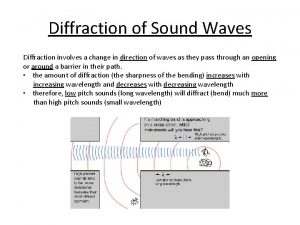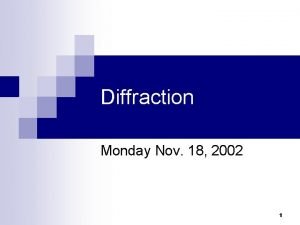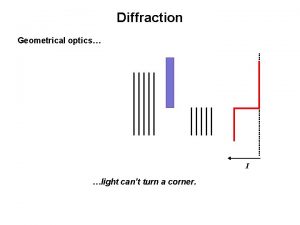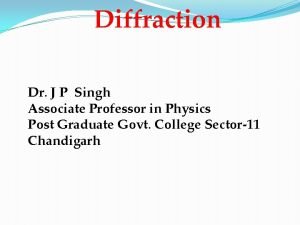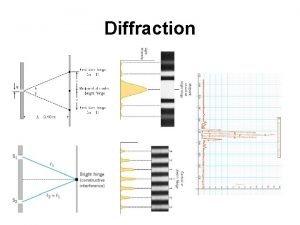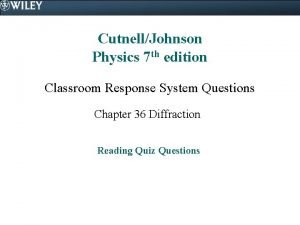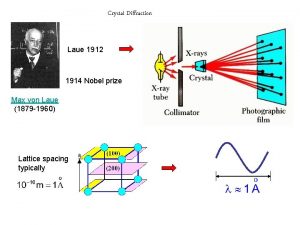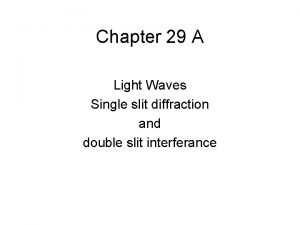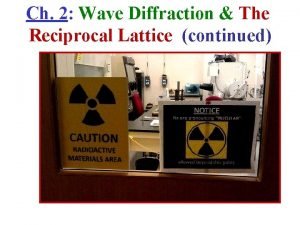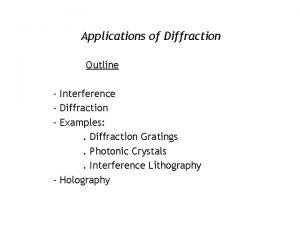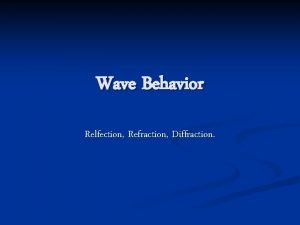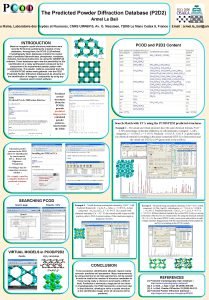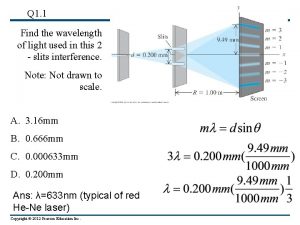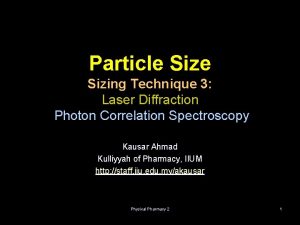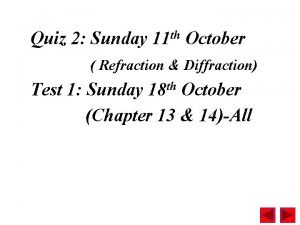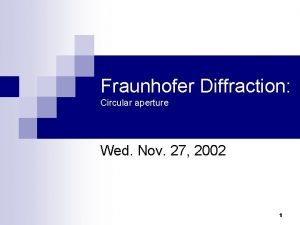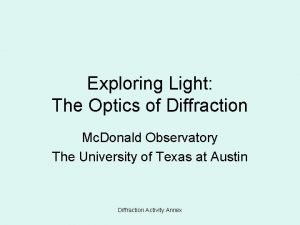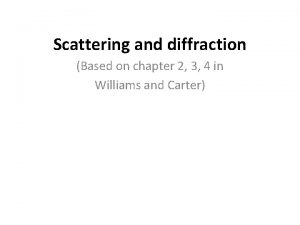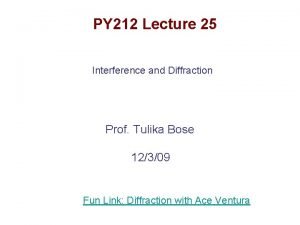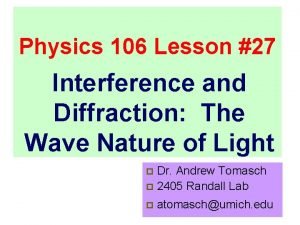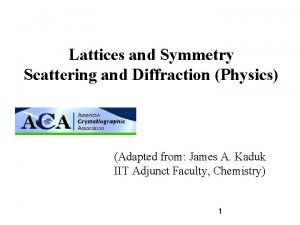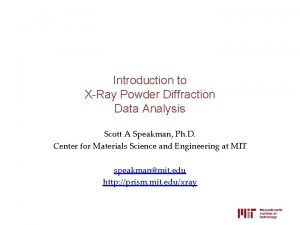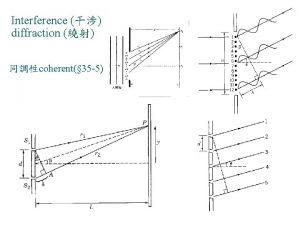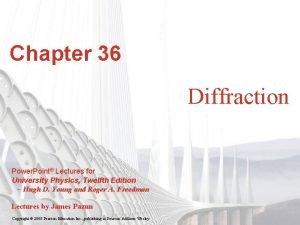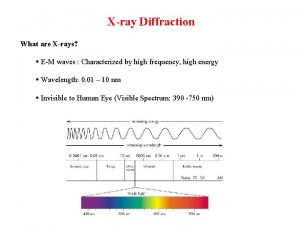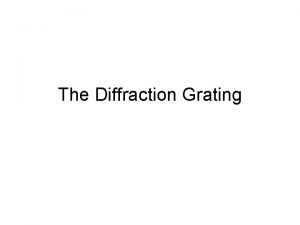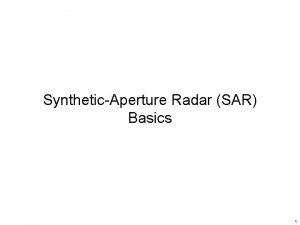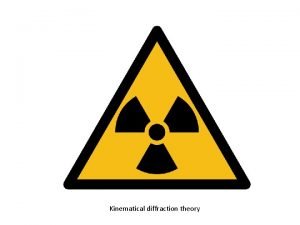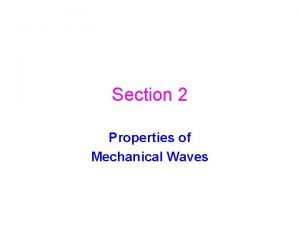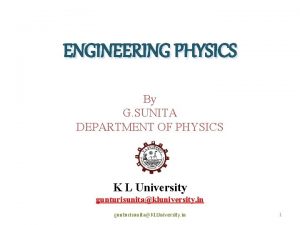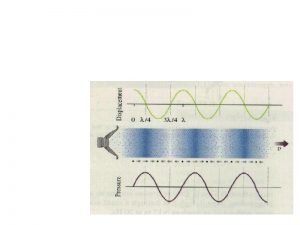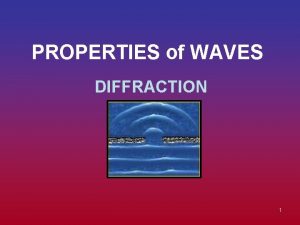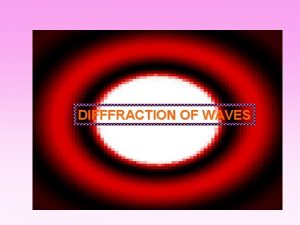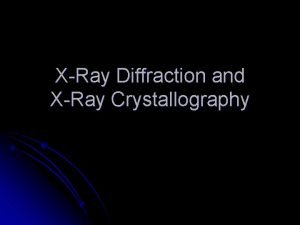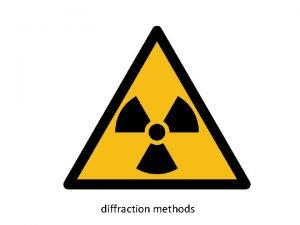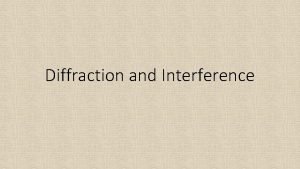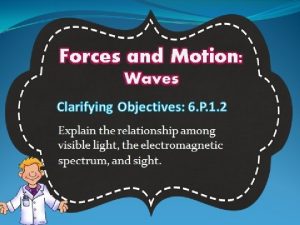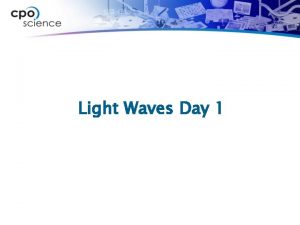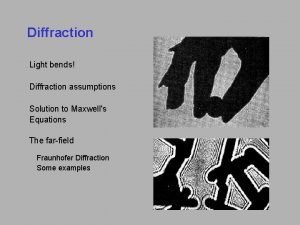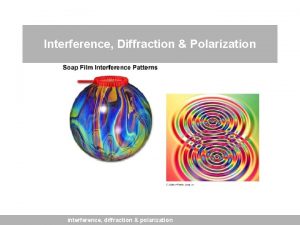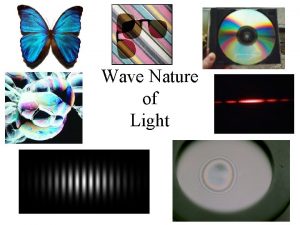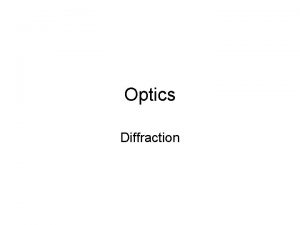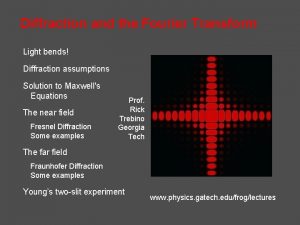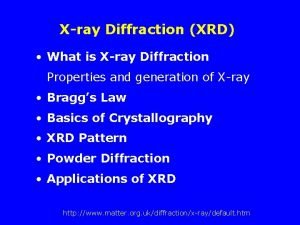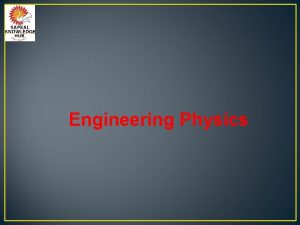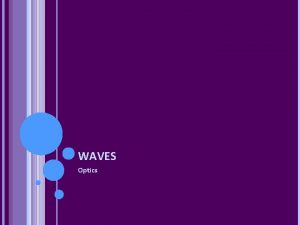Waves Light Waves Review Properties of Waves Diffraction






























































- Slides: 62

Waves & Light

Waves Review

Properties of Waves Diffraction – the bending and spreading of a wave when it passes through an opening; dependent on the size of the opening and the wavelength of the wave

Huygen’s Principle States: • Imagine a wave as being made up of an infinite number of tiny point wave sources, each of which spreads out on its own and allows the wave to continue • All these little waves are called wavelets • The difference in this model is that we only picture the portion of the “ripple” that spreads forward in the direction the wave is traveling

For diffraction to be observed: • The size of the opening or obstacle needs to be about the same size as the wavelength of the wave • If waves are to undergo more noticeable diffraction the wavelength must be comparable or greater than the slit width • If the wavelength is much bigger or smaller, the diffraction will be difficult(or impossible) to see

Quick Question 1) Determine whether diffraction will be noticeable when water waves of wavelength 1. 0 m pass through a 0. 5 m opening between two rock. 2) A laser shines red light with a wavelength of 630 nm onto an adjustable slit. Determine the maximum slit width that will cause significant diffraction of the light.

Interference – the phenomenon that occurs when two waves in the same medium interact

Conditions for Interference 1. Two or more waves are moving through different regions of space over at least some of their way from the source to the point of interest 2. The waves come together at a common point 3. The waves must have the same frequency and must have a fixed relationship between their phases such that over a given distance or time the phase difference between the waves is constant.

Recall: Coherent – composed of waves having the same frequency and fixed phases

Interference pattern between two identical sources

Node – a point along a standing wave where the wave produces a zero displacement Nodal line – a line or curve along which destructive interference results in zero displacements Path length – the distance from point to point along a nodal line Path length difference – the difference between path lengths or distances


Quick Question 1) Two point sources S 1 and S 2, are vibrating in phase and produce waves with a wavelength of 2. 5 m. The two waves overlap at a nodal point. Calculate the smallest corresponding difference in path length for this point.

Quick Question 2) Two point sources the vibrate in phase at the same frequency. They set up an interference pattern in which a point on the second nodal line is 29. 5 cm from one source and 25. 0 cm from the other. The speed of the waves is 7. 5 cm/s. a) Calculate the wavelength of the waves b) Calculate the frequency at which the sources are vibrating

Light: Wave or Particle? Newton’s Particle Theory of Light 1) Rectilinear Propagation 2) Reflection 3) Refraction Newton’s Theory could not explain diffraction

Light: Wave or Particle? Huygen’s Wave Theory of Light 1) Rectilinear Propagation 2) Reflection 2) Refraction 3) Diffraction

Young’s Double Slit Experiment • Young (1773 -1829) placed a screen that had two slits cut into it in front of a monochromatic (single color) light. • It produced an interference pattern

Light as a Particle If light is a particle: – only the couple of particles of light that go exactly where the slits are will be able to pass through – Since they are little particles they will make a pattern of two exact lines on the viewing screen

Light as a Wave If light is a wave: – Two light rays go through the slits, but as soon as they pass through they start to diffract. At some points the two sets of waves will meet crest to crest , at other spots crest meet trough – Where crest meets crest, there will be constructive interference and the waves will make a bright spot, where crest meets trough there will be destructive interference and there will be a dark spot


General Conditions required to create a wave interference • The interfering waves travel through different regions of space (two slits) • The waves come together at a common point where they interfere (screen) • The waves are coherent

Interference fringe- one of a series of alternating light and dark regions that result from the interference of waves Maxima –points of brightness, or maximum intensity, in an interference pattern Minima – points of darkness, or minimum intensity, in an interference pattern


• The middle line is the brightest, its called the central fringe and is given a value of 0 Constructive Interference (bright fringes) Destructive Interference (dark fringes) Occurs when the path difference is exactly half a wavelength more than any number of full wavelengths

Approximation of the wavelength of light Note: the distance between nodal line centers is identical to the distance between bright fringe centers. Relationship applies equally to dark and bright fringes. Relationship is only for small angles

Quick Question 1) Calculate the wavelength of the monochromatic light that produces a fifth order dark fringe at an angle of 3. 8° with a slit separation of 0. 042 mm. 2) The third order dark fringe of light with a wavelength of 652 nm is observed when light passes through two double slits onto a screen. The slit distance is 6. 3 x 10 -6 m. At what angle is the fringe observe?

Applications of the Wave Nature of Light 1) Interference in Thin Films 2) Single Slit Diffraction 3) Diffraction Grating

Interference in Thin Films Thin Film – a very thin layer of a substance, usually on a supporting material • A wave is inverted when it reflects from a fixed end or encounters a medium in which the speed of the wave decreases • A wave is not inverted when it reflects from a free end or when encountering a medium in which the speed of the wave increases


• For a film of thickness t, the distance traveled by the ray reflecting off the bottom layer is 2 t. • This causes a phase difference between the rays reflected off the top and bottom layers of the film. • Also need to consider the change in the wavelength due to refraction of the film. • Note: frequency remains the same on both sides of the boundary

• To determine the extra number of wavelengths the wave travels inside the film If the number of extra wavelengths, N - is a whole number, then the reflected and refracted ray are in phase and interfere constructively - is not a whole number, they are out of phase

For both waves having a phase change Constructive Interference: Destructive Interference:

When only one of the two waves has a inverted phase change Constructive Interference: Destructive Interference:

• The thickness of the film determines the color of light that will be strongly reflected • The thicker the thin film, the longer the wavelength of light that will produce constructive interference • Light waves become inverted when they reflect from the boundary of a medium that has a higher index of refraction than the original medium • No phase change occurs when light waves reflect from the boundary of a medium that has a lower index of refraction than the original medium


Quick Question 1) A soap film produces constructive interference of light of wavelength 500 nm, and a second film produces constructive interference of light with a wavelength of 600 nm. Determine which film is thicker. 2) A 510 nm wavelength of yellowish light is incident on an oil slick with an index of refraction of 1. 50 on top of a pool of pure water. Calculate thickness the oil slick needs to be so that you cannot see the yellowish light.

Newton’s Rings • Newton's rings are formed due to interference between the light waves reflected from the top and bottom surfaces of the air film formed between the lens and glass sheet.

Air Wedge – the air between two sheets of flat glass angled to form a wedge Separation between two fringes

Quick Question 1) A sheet of paper 0. 012 cm thick separates two sheets of glass to form an air wedge 10. 8 cm long. When the air wedge is illuminated with monochromatic light, the distance between the centers of the first and eighth dark bands is 2. 4 mm. Determine the wavelength of the light.

Quick Question 2) An air wedge 6. 0 cm long is formed from two pieces of glass separated at one end by a piece of paper. When light of wavelength 730 nm is reflected from the wedge, interference fringes appear. Between the dark fringes at both ends of the wedge, 62 bright fringes appear. Calculate thickness of the paper.

Single Slit Diffraction Fraunhofer Diffraction- an interference pattern that shows distinctive differences between the bright central fringe and darker flanking fringes Central maximum – the bright central region in the interference pattern of light and dark lines produced in diffraction Secondary maxima – the progressively lessintense bright areas, outside the central region in an interference pattern


Assume the following Conditions exist • The width, w, of the slit is narrow enough that a substantial amount of diffraction can occur, but not so narrow hat it acts as a single point source of waves • The light source is monochromatic with wavelength, λ • The light source is far from the slit, so that light rays that reach the slit are all traveling approx. parallel to each other

Path length difference: Destructive Interference (dark fringes) Constructive Interference (Bright fringes)


The angle for the first dark fringe Distance of the first minimum to the central maximum Note: the width of the central maximum is 2 y 1

Quick Question 1) Helium-neon laser light, with a wavelength of 7. 328 x 10 -7 m, passes through a single slit with a width of 43µm onto a screen 3. 0 m from the slit. Calculate the separation of adjacent minima, other than those on either side of the central maximum. 2) Monochromatic light falls onto a slit 3. 00 x 10 -6 m wide. The angle between the first dark fringes on either side of the central maximum is 25°. Calculate the wavelength of the light.

Differences between Interference & Diffraction of Light Interference Diffraction Due to superposition of two distinct waves coming from two coherent sources Is produced as a result of superposition of the secondary wavelets coming from different parts from the same wave front Interference pattern , all the bright fringes are the same intensity Diffraction pattern all the bright bands are not of the same intensity Interference pattern intensity of Diffraction pattern, intensity at minima is generally zero or very small minima is never zero and there is poor contrast between bright and dark bands The width of the fringes may or may not be equal Width of diffraction bands is always unequal

Resolution – the ability of an optical device to separate close objects into distinct and sharp images Recall: -smaller openings produce greater diffraction • If the opening is large, there is slight diffraction and the image is fuzzy but resolved • If the opening is small, significant diffraction and the image is unresolved

Diffraction Grating – a device with a large number of equally spaced parallel slits that produces interference patterns

Zero-order maximum – the location of maximum intensity in the diffraction pattern at First-order maximum- the first maximum of intensity on either side of the zero-order maximum in an interference pattern from a diffraction grating Order number – the value of m for a given maximum in a diffraction grating interference pattern; sequentially numbers the maxima on either side of the zero-order maximum

mth-Order Maximum

Quick Question 1) Consider two diffraction grating, one with 10 000 lines/cm and one with 8500 lines/cm. Compare the separations between adjacent maxima for these gratings. 2) A diffraction grating produces a third-order bright fringe at an angle of 22. 0° for red light with a wavelength of 694. 3 nm. Calculate the number of lines per centimeter on the grating.

Electromagnetic Radiation that consists of interacting electric and magnetic fields that travel at the speed of light.

Key Ideas • Electric charges in space produce an electric field, and currents produce a magnetic field • Magnetic field lines form continuous closed loops that have neither a beginning nor an end. Electric field lines always begin and end on charges • A changing electric field produces a magnetic field • A changing magnetic field produces an electric field

Properties of Electromagnetic Waves • An EM wave has both an electric field and a magnetic field • The electric and magnetic fields are perpendicular to each other and oscillate in phase • The direction of propagation of the wave is perpendicular to both


The Electromagnetic Spectrum The range of frequencies and wavelengths of all electromagnetic waves

Quick Question 1) An FM station broadcasts at 107. 1 MHz. Calculate the wavelength of its signal. 2) A helium-neon laser emits light with a wavelength of 638 nm. Calculate the period of the wave.

Polarization of Light Polarized Light – light waves that vibrate in a single plane Unpolarized light – light waves that vibrate in many different planes Polarizer- a device that allows only light with an electric field along a singe direction to pass through


Linearly polarized(Plane Polarized) – the quality of light waves that are polarized in one direction. Perpendicular to the direction of propagation.
 Diffraction of waves
Diffraction of waves Electromagnetic waves in water
Electromagnetic waves in water Diffraction
Diffraction Diffraction grating
Diffraction grating Diffraction is the tendency of light to:
Diffraction is the tendency of light to: Diffraction of light
Diffraction of light Electromagnetic waves are longitudinal waves true or false
Electromagnetic waves are longitudinal waves true or false Light light light chapter 23
Light light light chapter 23 Into the light chapter 22
Into the light chapter 22 Chapter 22
Chapter 22 Thin film formula
Thin film formula Reflection refraction diffraction interference
Reflection refraction diffraction interference Cmedium
Cmedium Multiple slits diffraction
Multiple slits diffraction Magnets for neutron diffraction
Magnets for neutron diffraction Absent spectra in diffraction grating
Absent spectra in diffraction grating Mobile ka
Mobile ka Principal maxima and secondary maxima
Principal maxima and secondary maxima Sound diffraction
Sound diffraction Fresnel and fraunhofer diffraction difference
Fresnel and fraunhofer diffraction difference Fresnel and fraunhofer difference
Fresnel and fraunhofer difference Missing order in diffraction
Missing order in diffraction Diffraction grating
Diffraction grating Diffraction in a sentence
Diffraction in a sentence Von laue
Von laue Diffraction and polarization
Diffraction and polarization Slit diffraction
Slit diffraction Laue equation
Laue equation Diffraction examples
Diffraction examples Blue relfection ray
Blue relfection ray Powder diffraction database
Powder diffraction database Diffraction through single slits derivation
Diffraction through single slits derivation Laser diffraction spectroscopy
Laser diffraction spectroscopy Find critical angle
Find critical angle Fraunhofer diffraction circular aperture
Fraunhofer diffraction circular aperture Diffraction
Diffraction Electron diffraction experiment results
Electron diffraction experiment results Diffraction and scattering
Diffraction and scattering Double slit diffraction
Double slit diffraction Slit diffraction
Slit diffraction Diffraction
Diffraction Diffraction peak
Diffraction peak Diffraction
Diffraction Slit diffraction
Slit diffraction Slit diffraction
Slit diffraction Xray waves examples
Xray waves examples Dispersive power of grating
Dispersive power of grating What is this phenomenon known as
What is this phenomenon known as Kinematical diffraction
Kinematical diffraction øystein prytz
øystein prytz Transmission grating
Transmission grating Extensive vs intensive quantity
Extensive vs intensive quantity Physical properties and chemical properties
Physical properties and chemical properties Kesler science
Kesler science 4 basic properties of waves
4 basic properties of waves Detail the measurable properties for all waves.
Detail the measurable properties for all waves. Properties of mechanical waves
Properties of mechanical waves Properties of mechanical waves
Properties of mechanical waves Properties of mechanical waves
Properties of mechanical waves Magnetostriction method to produce ultrasonic waves
Magnetostriction method to produce ultrasonic waves 4 basic properties of waves
4 basic properties of waves Similarities of mechanical waves and electromagnetic waves
Similarities of mechanical waves and electromagnetic waves Mechanical waves and electromagnetic waves similarities
Mechanical waves and electromagnetic waves similarities
